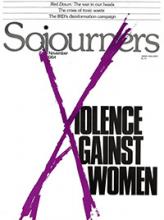At a women's meeting in Sojourners Community a few years ago, we were discussing the vulnerability that we feel as women in an inner-city Washington, D.C. neighborhood.
"It's easiest to be friendly to children, and also easy to be warm to women and older people. But when I see a young man coming toward me, I feel myself closing in. I'm never sure whether to smile or speak or look right past him. I usually just look at the ground."
This comment got us sharing with one another the encounters that had brought us face to face with our own fears and powerlessness, and which had left us with a lamentable posture of vigilance in a neighborhood that we call home.
Each of us had experienced verbal assaults on the street. Some of these were violent, others couched as invitations—and all were aimed at our integrity.
Some women spoke of places that still held fearful memories: a bus stop where an exhibitionist once approached, a bank of shrubbery from which a man shouting obscenities emerged, a corner on which an attempted rape was fought off. We shared experiences from other times and settings: an inappropriate examination by a male doctor in the D.C. jail after a peace witness arrest, sexual advances from a college professor, a rape in an apartment and another behind a house. And we added to our own experiences those of other women we knew.
Read the Full Article
